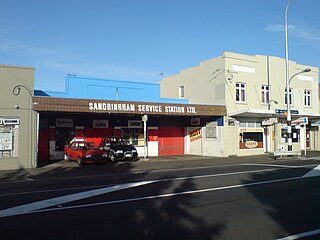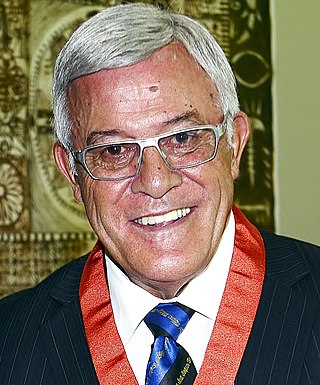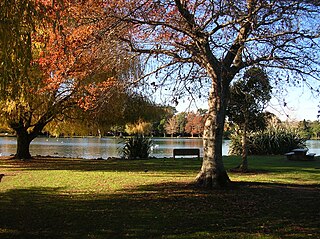
Mount Eden is a suburb in Auckland, New Zealand whose name honours George Eden, 1st Earl of Auckland. It is 4 kilometres (2.5 mi) south of the Central Business District (CBD). Mt Eden Road winds its way around the side of Mount Eden Domain and continues to weave back and forth as it descends into the valley; it runs south from Eden Terrace to Three Kings. Mt Eden village centre is located roughly between Valley Road and Grange Road. The domain is accessible on foot from many of the surrounding streets, and by vehicle from Mt Eden Road. The central focus of the suburb is Maungawhau / Mount Eden, a dormant volcano whose summit is the highest natural point on the Auckland isthmus.

Mount Albert is an inner suburb of Auckland, New Zealand, which is centred on Ōwairaka / Mount Albert, a local volcanic peak which dominates the landscape. In the past Mt. Albert also referred to the 2,500 acre borough that was created in 1911 on the outskirts of Auckland City. Mt. Albert was also one of the original five wards within the Mt. Albert Borough. The suburb is located seven kilometres to the southwest of the Central Business District (CBD).

Morningside is a suburb of Auckland, New Zealand. It lies four kilometres south-west of the city centre, close to Eden Park and Western Springs Reserve.

Sandringham is a suburb of Auckland, New Zealand. It is a multi-ethnic suburb with a population of over 12,000.

Owairaka is a suburb of New Zealand's largest city, Auckland. It is under the local governance of the Auckland Council. The area was primarily rural until the 1930s, when the area experienced suburban growth. Owairaka is known for the Owairaka Athletic Club, a club that came to prominence in the 1960s, due to the success of coach Arthur Lydiard and athletes Murray Halberg and Peter Snell.

Kingsland is an inner-city suburb of Auckland, the largest and most populous urban area in New Zealand. Kingsland is under the local governance of the Auckland Council. It is the home of Eden Park, New Zealand's largest stadium, which hosted the finals for the 2011 Rugby World Cup. Kingsland has a village centre that contains a series of shops, restaurants, pubs and monthly markets.

Sir Bryan George Williams is a former New Zealand rugby union footballer and former coach of the Samoan national rugby team.

Fowlds Park is a small public reserve in the northern part of Mount Albert, in Auckland City.

Dame Miriam Patricia Dell was a New Zealand women's advocate, botanist and schoolteacher. She was the president of the National Council of Women of New Zealand from 1970 to 1974 and the first New Zealand president of the International Council of Women from 1979 to 1984. She established the Committee on Women, the forerunner to New Zealand's Ministry for Women. Her work on promoting women's rights and advancement led to her being appointed a Member of the Order of New Zealand in 1993, New Zealand's highest civilian honour.

Ōwairaka / Mount Albert, also known as Te Ahi-kā-a-Rakataura, is a volcanic peak and Tūpuna Maunga which dominates the landscape of the Owairaka and Mount Albert suburbs of Auckland.
Richard Ellis Ford Matthews was a New Zealand plant virologist.
Edward George Bollard was a New Zealand plant physiologist and science administrator.
Jeffery Lewis Tallon is a New Zealand physicist specialising in high-temperature superconductors.
The Karitane Hospitals were six hospitals in New Zealand run by the Plunket Society, located in Auckland, Christchurch, Dunedin, Invercargill, Wanganui and Wellington. They were established as training hospitals for Karitane nurses and cared for babies with malnutrition and other dietetic complaints, and premature babies. They also offered mother care training and assistance. The first hospital opened in 1907 and the hospitals were closed between 1978 and 1980 due to financial difficulties and changes in society and maternity services.

Western Springs Reserve, also known as Western Springs Lakeside Te Wai Ōrea, consists of a sanctuary for wildlife, surrounding a lake fed by the natural springs. There are walking paths surrounding the lake with bridges going across sections of it. Auckland Zoo, Museum of Transport & Technology and Western Springs Stadium are all situated around the park.

Kōwhai Intermediate School is a state co-educational intermediate school located in the suburb of Kingsland in Auckland, New Zealand. The school opened in October 1922, and was the first intermediate school in New Zealand.

New North Road is a street in the central and western Auckland isthmus, New Zealand, connecting Upper Symonds Street in Eden Terrace to Avondale. The road runs parallel to Great North Road, located to the north, and crosses Dominion Road, the Western Line at Morningside and runs above the Waterview Tunnel section of the Southwestern Motorway at Mount Albert.

Gribblehirst Park is a park in central Auckland, New Zealand, close to the suburbs of Sandringham and Morningside. Originally the park was known as Cabbage Tree Swamp.

Alberton is a 19th-century house in Mount Albert, Auckland, New Zealand, which is listed by Heritage New Zealand as a Category I structure. The house was built in the 1860s for the Garlick family, major figures in the Methodist community in Mount Albert, later becoming a hub for the Plunket Society in the 1940s and a community centre.

St Lukes is a suburb of New Zealand's largest city, Auckland. It is under the local governance of the Auckland Council. After Westfield St Lukes opened in 1972, the area developed into a major commercial area of the Auckland isthmus.


















